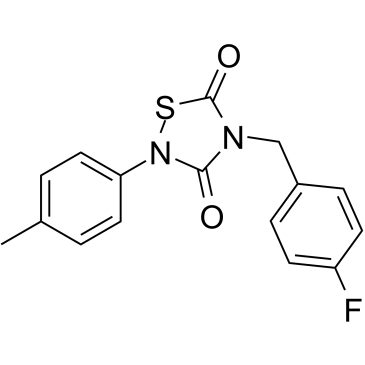| Cas No.: | 883050-24-6 |
| Chemical Name: | 4-[(4-Fluorophenyl)methyl]-2-(4-methylphenyl)-1,2,4-thiadiazolidine-3,5-dione |
| Synonyms: | CCG50014;CCG 50014 |
| SMILES: | FC1C=CC(CN2C(=O)SN(C3C=CC(C)=CC=3)C2=O)=CC=1 |
| Formula: | C16H13FN2O2S |
| M.Wt: | 316.35 |
| Purity: | >98% |
| Sotrage: | 2 years -20°C Powder, 2 weeks 4°C in DMSO, 6 months -80°C in DMSO |
| Description: | CCG-50014 is the most potent against the regulator of G-protein signaling protein type 4 (RGS4) (IC50 =30 nM) and is >20-fold selective for RGS4 over other RGS proteins. CCG-50014 binds covalently to the RGS, forming an adduct on two cysteine residues located in an allosteric regulatory site[1]. CCG50014, reduces nociceptive responses and enhances opioid-mediated analgesic effects in the mouse formalin test[2]. |
| Target: | RGS4:30 nM (IC50) RGS8:11 μM (IC50) RGS16:3.5 μM (IC50) RGS19:0.12 μM (IC50) |
| In Vivo: | CCG50014 (10, 30, or 100 nM) attenuates the nociceptive responses during the late phase in a dose-dependent manner[2]. |
| References: | [1]. Blazer LL, et al. A nanomolar-potency small molecule inhibitor of regulator of G-protein signaling proteins. Biochemistry. 2011 Apr 19;50(15):3181-92. [2]. Yoon SY, et al. Intrathecal RGS4 inhibitor, CCG50014, reduces nociceptive responses and enhances opioid-mediated analgesic effects in the mouse formalin test. Anesth Analg. 2015 Mar;120(3):671-7. |

 To enhance service speed and avoid tariff delays, we've opened a US warehouse. All US orders ship directly from our US facility.
To enhance service speed and avoid tariff delays, we've opened a US warehouse. All US orders ship directly from our US facility.




















